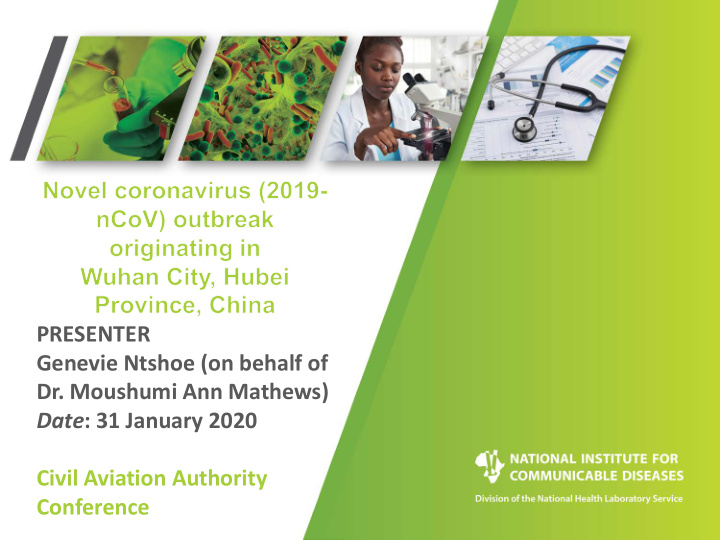



PRESENTER Genevie Ntshoe (on behalf of Dr. Moushumi Ann Mathews) Date : 31 January 2020 Civil Aviation Authority Conference
Human coronaviruses First isolated in the 1960s Circulate among animals (zoonotic) and humans HCoVs, which commonly cause mild upper respiratory tract infections (URTIs): HCoV-229E HCoV-OC43 HCoV-NL63 HCoV-HKU1 Recent zoonosis with more severe disease (LRTI): SARS-CoV (2002-2003 global outbreak; spread to 37 countries within 2 weeks of original outbreak reporting; 8,098 probable cases and 774 deaths) MERS-CoV (first ID-ed in 2012; as of Oct 2019 >2400 lab-confirmed cases with >850 deaths; high mortality; mostly contained within the Middle East, but has been detected in 17 other countries.)
2019-nCoV • Identified Dec 2019 in Wuhan City of the Hubei Province 2019-nCoV • Zoonotic, but unknown source • >6000 lab-confirmed cases, >150 deaths • Limited human-to-human transmission evidenced by infection of – Close household contacts – Health care workers • All reported cases: – Travel history to Wuhan City OR – Contact with confirmed case
2019-nCoV
2019-nCoV Timeline
2019-nCoV global reach
Clinical presentation • Limited information • Mainly clinical features fever and cough • Few patients presenting with difficulty in breathing and bilateral infiltrates on chest X-rays • Of 7783 confirmed cases with available data (29 January) – 170 deaths (CFR=2.2%) – 133 recovered – Treatment: supportive • No antivirals or vaccines
Current NICD case definition for testing Severe illness – Any person with a severe acute respiratory illness (SARI), i.e. fever (≥38 °C) or history of fever and cough with pneumonia or Acute Respiratory Distress Syndrome (ARDS) (based on clinical/ radiological findings) requiring admission to hospital AND any of the following: – A documented travel history to Hubei Province , China within 14 days before symptom onset; or – Patient is a healthcare worker who was exposed to patients with severe acute respiratory infections unless another aetiology has been identified to explain the clinical presentation * Please check www.nicd.ac.za for latest update
Current NICD case definition Respiratory illness of any degree – A person with acute respiratory illness (ARI) of any severity who presented with symptom onset within 14 days and had been exposed to the following: – Close physical contact with a confirmed patient with nCoV-2019 while he/she is symptomatic; or – Healthcare facility in a country where hospital-associated nCoV-2019 infections have been reported; or – Any direct contact with animal source in countries where nCoV-2019 is known or where human infections have occurred (due to the animal source remaining undetermined, guidance for this point will be updated); or – A documented travel history to Hubei Province, China within 14 days of symptom onset * Please check www.nicd.ac.za for latest update
Please Note: • China is doing exit screening of all passengers leaving the country • Passengers from China are finding new and innovative travel routes to facilitate entry into the country so screening direct flights from China is no longer enough
Target Flights: In the event of a suspected case… • Communicate general awareness about current 2019-nCoV to all passengers on board; encourage them to complete brief screening tool • If a sick traveler is coughing, ask him/her to wear a face mask. If no mask is available or the sick traveler cannot tolerate In flight the mask, e.g. because of breathing difficulties, provide tissues and ask him/her to cover the mouth and nose when coughing, sneezing or talking (IATA Guidelines) • Administer brief screening questionnaire • If a suspect case is identified in-flight – report to Port Health • Port Health with further assess any passengers at risk At Port of entry • Port Health to report any suspect cases after review into the country to Provincial CDC & NICD Presenting to a • Many passengers will only present to their Clinician after healthcare providers after leaving the airport leaving the • Please provide them with contact details if airport symptoms do develop
References 1. Ksiazek TG et al . A novel coronavirus associated with severe acute respiratory syndrome. (2003) NEJM . Vol 348 (20). 2. Corman V, Landt O, Koopmans M, Zambon M, Peiris M. Diagnostic detection of Wuhan coronavirus 2019 by real-time RT-PCR. (13 Jan 2020) Published on https://www.who.int/health-topics/oronavirus/laboratory-diagnostics-for-novel- coronavirus 3. https://www.cdc.gov/coronavirus/2019-ncov/summary.html 4. https://www.who.int/internal-publications-detail/clinical-management-of-severe- acute-respiratory-infection-when-novel-coronavirus-(ncov)-infection-is-suspected
• Prof Cheryl Cohen (Head: Center for Respiratory Diseases and Meningitis)
Recommend
More recommend